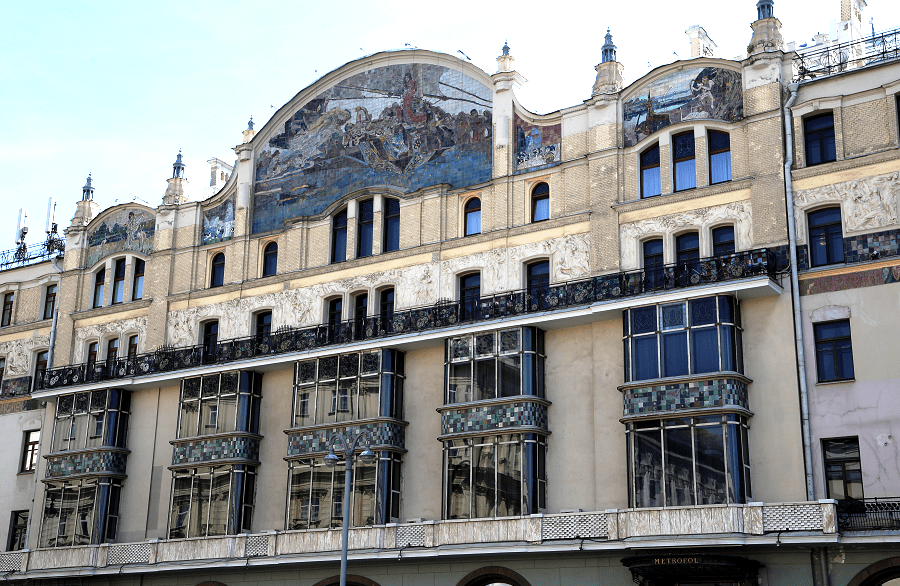The Metropol Hotel is a 5-star class hotel in the center of Moscow. It was built between 1899 and 1905. Savva Mamontov initiated the construction and ordered William Walcot (a Scottish architect, graphic artist and etcher) to develop the initial project.
The Metropol building plays an extremely important role in shaping the appearance of Teatralnaya Ploschad and Ploschad Revolyutsii.
The hotel is the largest public building of the Art Nouveau era and is recognized as one of the most significant Moscow historical and architectural monuments of this style.
A galaxy of well-known and talented architects and artists worked on the creation of the hotel complex. In addition to William Walcot, Lev Kekushev and Nikolai Shevyakov, architects P. P. Visnevsky, S. S. Shutsman, V. V. Voeikov, S. P. Galenzovsky, V. I. Rubanov, M. M. Peretyatkovich, I. A. German, P. Vulsky, A. Erichson, V. Vesnin, I. Zholtovsky and (presumably) F. Shekhtel participated in the development of interiors. Paintings and elements of interior decor were made according to the sketches of V. Vasnetsov and K. Korovin. In contrast to the facades, designed in strict stylistic unity, polystylism characterized the interior decoration: there are interiors in the Russian style and the spirit of neoclassicism.
Vrubel’s panel “Princess Dream” on the Northern side of the hotel wall is called the most famous panel in Moscow. It was based on the plot of the drama in verse by Edmond Rostand La Princesse lointaine, in the Russian translation by T. L. Shchepkina-Kupernik, called “Princess Dream”. One of the characters in the play is the troubadour, Jofre Rudel.
The grand opening of the Metropol took place in 1905. The hotel was equipped with electric lighting, ventilation, elevators and telephones and separate toilet rooms were installed in all rooms. In addition, it had a reading room, a room for correspondence, a post and a telegraph office.
For its time, the Metropol was a hotel complex with 400 rooms, unique in size, comfort and decoration, of which, following the spirit of the modern era, there were no two identical. The hotel rooms provided refrigerators (filled with ice), telephones and hot water. In 1906, under the name “Modern Theatre”, the first two-screen cinema in Moscow was opened at the hotel. On the sixth floor of the hotel is the editorial office of the magazine “Vesy”, which is the main printed organ of Russian symbolists.
The Metropol restaurant, which can accommodate up to 1,700 people (that’s how many seats were provided for the celebration of the New Year), was popular among different segments of society.
In early March 1918, after the Soviet government moved to Moscow, the Metropol became one of the main residences of the new government, receiving the name of the Second House of Soviets (the National Hotel became the First House of Soviets).
Here, until 1919, meetings of the All-Russian Central Executive Committee were held in the converted restaurant, at which V. I. Lenin, L. D. Trotsky and M. I. Kalinin regularly spoke. On the second floor was the reception room of Yakov Sverdlov, chairman of the All-Russian Central Executive Committee; on the third – the People’s Commissariat for Foreign Affairs. Some prominent Bolsheviks lived in the hotel rooms – Georgy Chicherin, Nikolai Bukharin, Vladimir Antonov-Ovseenko, Matvey Muranov, Alexander Shlikhter, Sergei Grintser and others.
According to legend, it was in the Metropol that the poet Sergei Yesenin first talked about his love forthe dancer Isadora Duncan. After returning from emigration in 1943, Alexander Vertinsky and his family lived in the Metropol for about three years; his daughter Anastasia was born here.
Bernard Shaw, Bertolt Brecht, Mao Zedong, Marlene Dietrich, John Steinbeck and Ilya Repin stayed here at different times.
In 1986-1991, the Finnish construction company (YIT-Yhtymä Oy; architect Kari Mekkälä, project manager Sakari Rahko) in cooperation with workshop No. 13 of Mosproekt-2restored and reconstructed the hotel. During the restoration work, the facades acquired their original appearance; in the interior, the original wall paintings were uncovered from the layers of paint and restored, and many elements of the decorative design were restored. Most of the interior, including 32 lettered hotel rooms, the European and Boyarsky restaurants, as well as the legendary main hall of the restaurant with a richly painted glass dome and banquet halls located on the second floor of the restaurant, was restored to its original form based on historical architectural research.
In subsequent years, heads of state and government, and movie, pop and sports stars stayed at the hotel. Among the guests of honor of the Metropol are French Presidents Jacques Chirac and Pakistani Pervez Musharraf, Chinese President Hu Jintao, couturier Giorgio Armani and Pierre Cardin, singers Elton John, Michael Jackson, Julio Iglesias and his son Enrique, opera stars Montserrat Caballe and Placido Domingo, film directors Francis Ford Coppola and Luc Besson, actresses Catherine Deneuve, Annie Girardot, Sharon Stone and many others.
Honoring Galina Vishnevskaya and Mstislav Rostropovich became a special event in the history of the hotel. In the restaurant “Metropol” in May 2005, the golden wedding of an eminent couple was celebrated. Among the guests at the celebration was Queen Sofia of Spain, Queen Beatrix of the Netherlands, wife of French President Bernadette Chirac, first President of Russia Boris Nikolayevich Yeltsin with his wife Naina Iosifovna and others.
Located at the address: Teatralniy proezd, 2.
Nearest metro: Ohotny Ryad, Teatralnaya, Lubyanka.
Attractions around: Bolshoi Theatre, Maly Theatre, Manezhnaya Square, Ploschad Revolyutsii (square), State Duma building, House of the Unions, Moskva hotel, Red Square, Tverskaya street, Kremlin.
See all hotels in Moscow.












